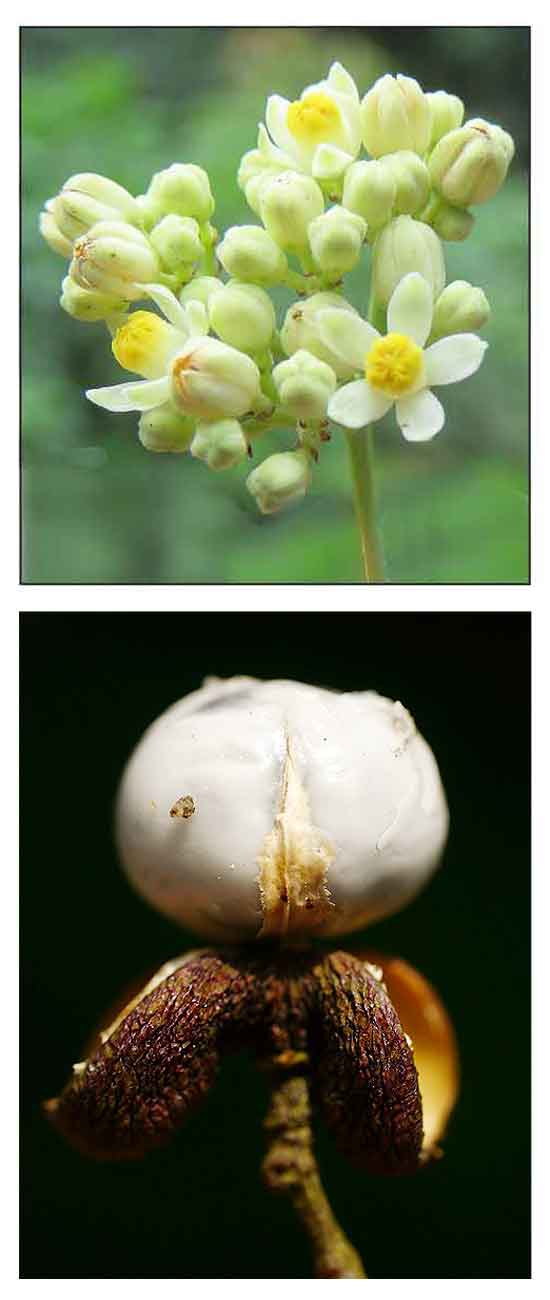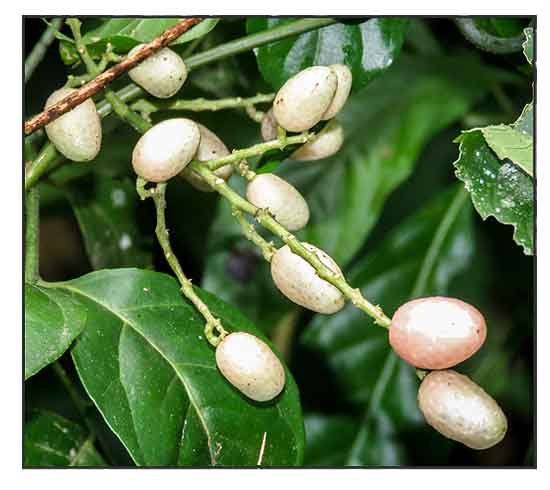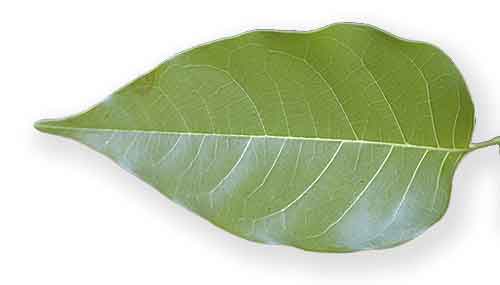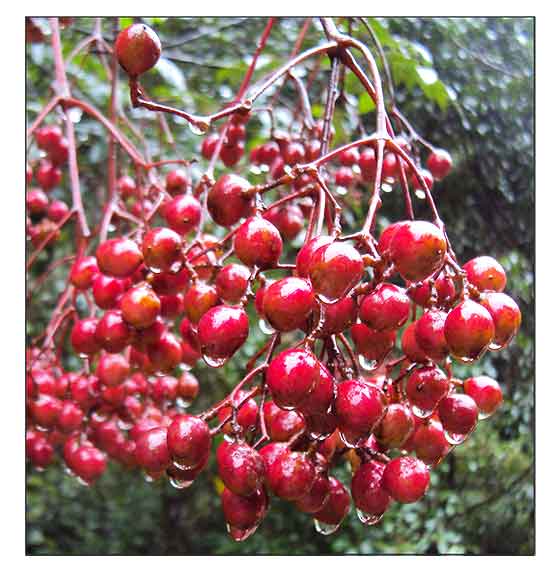
Family • Meliaceae
Kalibaian
Heynea trijuga Roxb. ex Sims
INDIAN HEYNEA
Zhe gu hua
| Scientific names | Common names |
| Ailantopsis poilanei Gagnep. | Kalibaian (Tagalog) |
| Heynea affinis A.Juss. | Gargu (Engl.) |
| Heynea connaroides (Wight & Arn.) Wught ex Voigt | Indian Heynea (Engl.) |
| Heynea fruiticosa Teijsm. & Binn. | |
| Heynea pubescens Hook.f. | |
| Heynea quinquejuga Roxb. ex G.Don. | |
| Heynea quinquejuga A.Juss. | |
| Heynea sumatrana Miq. | |
| Heynea trijuga Roxb. ex Sims | |
| Heynea trijuga var. microcarpa Pierre | |
| Heynea trijuga var. multijuga C.DC. | |
| Heynea trijuga var. pilosula C.DC. | |
| Heynea trijuga f. pubescens (Kurz) Craib | |
| Heynea trijuga var. velutina Gagnep. | |
| Leea laevis B.Heyne ex Wall. | |
| Melia integerrima Buch.-Ham. | |
| Picroderma laotica Gagnep. | |
| Scutinanthe engleri Elmer | |
| Trichilia affinis (A.Juss.) M.R.Almeida | |
| Trichilia connaroides (Wight & Arn.) Bentv. | |
| Trichilia connaroides f. glabra Bentv. | |
| Trichilia connaroides var. microcarpa (Pierre) Bentv. | |
| Trichilia rimosa Blanco | |
| Walsura intermedia Craib | |
| Walsura pallida Craib | |
| Walsura perrottetii C.DC. | |
| Walsura pubescens Kurz | |
| Walsura punctata Suess. | |
| Walsura quinquijuga Kurz | |
| Walsura sumatrana (Miq.) Harms ex Koord. | |
| Walsura tenuifolia Ridl. | |
| Walsura trijuga (Roxb. ex Sims) Kurz | |
| Walsura trijuga var. microcarpa (Pierre) S.Y.Hu | |
| Walsura trijuga var. pubescens Kurz | |
| Zanthoxylum connaroides Wight & Arn. | |
| Zygophyllum connaroides Wight & Arn. ex Hiern | |
| Heynea trijuga inermis is an accepted species. KEW: Plants of the World Online | |
| Other vernacular names |
| BORNEO: Buah pasat. |
| CHINA: Ze gu hua. |
| INDIA: Yelakathokakarra; Thengare-arong (Assamese); Kora, Limbara, Linabira (Kannada); Korakadi, Korakkadi, Kurukkati (Malayalam); Limbara, tusal (Marathi); Aankhataruwa, Komal-siuli, Singamur, Aankh taare (Nepali); Centanai, centarai, Karai, Karaivilanku (Tamil). |
| MYANMAR: Taagat-ta-gyi. xxxx. |
| NEPAL: Aankhaataruwaa. |
Botany Distribution  Constituents Constituents- GC-FID analysis of kernel oil showed an oil contend of 37.61% (w/w). The seed oil was rich in unsaturated fatty acids. Monounsaturated fatty acids (MUFA) were dominant (38.81%) compared to polyunsaturated fatty acids (PUFA) (16%). Important acids were palmitic (22.12%), stearic acid (7.51%), oleic acid (25.20%), and linoleic acid (11.65%). (see study below) (5) - Study of leaves and twigs isolated seven phenolic compounds: 3-O-caffeoylquinic acid (1), 4-O-caffeoylquinic acid (2), 5-O-caffeoylquinic acid (3), protocatechulic acid (4), caffeic acid methyl ester (5), quercetin 3-O-β-D-glucopyranoside (6) and kaempferol 3-O-β-D-glucopyranoside (7). (6) - Study isolated eleven previously undescribed limonoids from the fruits of Heynea trijuga viz. eight structural analogues of trigging (1-8), and three (9-11) melancholic derivatives, together with two known compounds, trichloroethane A and B (12-13) from ripe fruits of T. colonnades. (see study below) (8) - Study isolated five new melancholic-type limonoids, heytrijunolides A-E (1-5) from branches and leaves of Heynea trijuga. (see study below) (9) - Study of leaves isolated a new ergostane derivative, 3β, 4β, 20S-trihydroxyergosta-5, 24(28)-dien-16-one (1), together with five known steroids (3β, 23S)-ergosta-5, 24(28)-diene-3, 23-diol (2), ergosta-5, 24(28)-diene-3β-diol (3), stigmast-5-ene-3β, 7α-diol (4), sitoindoside I (5) and stigmast-3β, 5α, 6β-triol (6). (see study below) (10) - Study of stem and bark of Trichilia connaroides isolated eight new nortriterpenoids (1-8), along with fifteen known compounds (9-23). (see study below) (14) - GC-MS analysis of ethyl acetate extracts of Trichilia connaroides revealed the presence of over 45 compounds of which 22.06, 97.24, 46.42, and 58.27% of total volatiles from the extract were identified from leaves, bark, root, and pericarps, respectively. Bark was rich in sesquiterpenoids. Major constituents of the total volatiles were capaene (24.71%), azulene (17.47%), α-cubebene ( 14.98%), ß-cadinene (12.58%), α-bergamotene (4.96%) and ylangene (5.50%). (see study below) (17) Properties Availability |
April 2024
![]()
 |
| PHOTOS / ILLUSTRATIONS |
| IMAGE SOURCE: Heynea trijuga / Rejoice Gassah / CC_BY / Image modified / Click on image or link to go to source page / BIODIVERSITY INDIA |
| IMAGE SOURCE: Heynea trijuga / Rejoice Gassah / CC BY-SA 3.0 / Image modified / Click on image or link to go to source page / BIODIVERSITY INDIA |
| IMAGE SOURCE: Heynea trijuga - Trichilia connarioides / Vinayaraj / CC_BY / Click on image or link to go to source page / Wikimedia |
| OTHER IMAGE SOURCE: Heynea trijuga - Trichilia connarioides / Flower closeup / Vinayaraj / CC BY-SA 4.0 International / Image modified / Click on image or link to go to source page / Wikimedia Commons |
| OTHER IMAGE SOURCE: Heynea trijuga / Arillate fruit / Rohit Naniwadekar / CC BY-SA 4.0 / Image modified / Click on image or link to go to source page / Species.Wikimedia |
Additional
Sources and Suggested Readings |
• |
DOI: It is not uncommon for links on studies/sources to change. Copying and pasting the information on the search window or using the DOI (if available) will often redirect to the new link page. (Citing and Using a (DOI) Digital Object Identifier) |
| List of Understudied Philippine Medicinal Plants |
| New plant names needed The compilation now numbers over 1,300 medicinal plants. While I believe there are hundreds more that can be added to the collection, they are becoming more difficult to find. If you have a plant to suggest for inclusion, native or introduced, please email the info: scientific name (most helpful), local plant name (if known), any known folkloric medicinal use, and, if possible, a photo. Your help will be greatly appreciated. |
• |
 |




